Karl Hess on anarchocapitalism
As you may know, I’ve got some opinions about capitalism, and about the idea of anarcho-capitalism.
I think that anarcho-capitalism
is an incoherent goal, and one which it is in some ways actively destructive to adopt. Not because I’ve got a problem with property, money, competition or market exchange, but because I think the conflation of these market forms with capitalistic concentrations of ownership and corporate business practices depends on a series of conceptual confusions, and some flat economic blunders. Moreover, while there are a wide range of views on these things among those who identify themselves as anarcho-capitalists,
I think that among other things, it has mostly tended to encourage all the wrong habits in the people who use it — I think that it has encouraged disproportionately business-centric rather than people-centric understandings of what economic freedom means and what it is good for; that it has constrained the imagination about what a free society might look like, to a really damaging extent;[1] that it encourages some wildly false and blinding beliefs about the origins of statist control;[2] that it systematically tends to recommend thinner rather than thicker conceptions of liberty, and so has been closely connected with a sometimes really toxic embrace of cultural conservatism and defensiveness about many forms of status-quo social privilege; and that the anarcho-capitalist stance has typically involved a dangerous and deliberate indifference to the dangerous effects that a context of highly concentrated or class-stratified patterns of ownership, management, and access to social or economic capital, can have in damaging and deforming market dynamics. It is in fact my view that capitalism is not compatible with anarchism — that in actual fact, anarchy would undermine and destroy capitalist patterns of ownership and management wherever they existed; and that attempts to defend capitalism more or less always end up falling back on serious errors or compromises of important anarchist principles.
But, all that said, I also am not really interested at all in issuing dogmatic definitions to the effect that anarcho-capitalists
cannot possibly count as genuine anarchists. I think that they are wrong; and that they are inconsistent. I also think that many anti-capitalist anarchists are wrong, and that many anti-capitalist anarchists are inconsistent. Moreover, I think that there are anarcho-capitalists who have done good and important work which it’s worthwhile for other anarchists to study — both work about anarchist history,[3] and also work in contemporary anarchist theory; and I think this work, even when it’s deeply mistaken, is worth taking the time to study with care and with a good-faith effort at charitable understanding. Unfortunately, some left-libertarians, in the effort to criticize what’s wrong with right-wing anti-statism and anarcho-capitalism, end up taking cheap shots at something that’s more reflective of their impressions of contemporary debates with pro-capitalist types than it is the actual history of anarcho-capitalist labels or ideas. For example, a while back C4SS posted a perfectly righteous little post anarcho-capitalism
, criticizing it from a left-libertarian, anti-capitalist perspective. As well it should be criticized. Then, in comments, Tom Blanton added this:
I believe the term “anarcho-capitalist” was devised to appeal to conservatives (and their balanced checkbooks). While anarchism is scary and radical to conservatives, a guy in a suit and tie calling himself an anarcho-capitalist is not so threatening, especially when they support Republican presidential candidates. That sends a signal that maybe they don’t really want to abolish the state, but really just want some tax cuts and less regulations – just like Ronald Reagan!
And Dave Hummels followed it up by saying:
Ha! I think you have summed up Murray Rothbard’s appeal nicely. Well done, Tom.
If an-caps are looking for a new label, I have a suggestion: Bossertarian. I don’t know if it rolls of the tongue that smoothly, but it I think it’s a more honest portrayal of where their sympathy lies.
This is a common line; and honestly it is something of a self-congratulatory narrative among left-libertarians, when we’re trying to explain where the free-market anti-capitalist view comes from, and how it differs from anarcho-capitalism.
But while I can’t speak to all the sources of Murray Rothbard’s appeal, I can say that, contrary to popular opinion, the term anarcho-capitalism
was not — as far as anyone can tell — coined by Murray Rothbard.
Rothbard did, of course, use the term very frequently later on in his career; and he was calling himself an anarchist,
and describing his views as a form of anarchism,
throughout the 1960s. And certainly those who first called themselves anarcho-capitalists
were heavily influenced by Rothbard’s ideas. But the specific formulation of the term anarcho-capitalism
does not, as far as I have been able to find, originate in Rothbard’s writing. The term does not seem to appear in print at all before 1969; Rothbard used it occasionally during 1969,[4] but did not use it very extensively in his own writing until the early 1970s. The earliest uses of the term is sometimes attributed to the anarcho-Randian Jarret Wollstein’s 1969 pamphlet, Society Without Coercion: A New Concept of Social Organization, where Wollstein introduces the term anarcho-capitalism
in section 2.4, Naming a Free Society;
but he introduces it there as a term that people in his circles had already been tossing around, and I don’t yet know of any good way to determine whether this section reflects content that was included in the February, 1969 talk that the pamphlet was based on; or whether the term anarcho-capitalism
was introduced when the talk was re-edited and expanded into a print pamphlet in August, 1969.[5]
In fact, the earliest documentable, printed use of the word anarcho-capitalism
that I can find,[6] actually comes neither from Wollstein, nor from Rothbard, but from Karl Hess’s manifesto “The Death of Politics,” which was published in Playboy in March 1969. And the way it’s used there, if you see something calculated to appeal to business conservatives, I want to know what kind of conservatives you know. Here’s Karl; watch as he flies past, breaking the ideological sound barrier. Boldface mine.
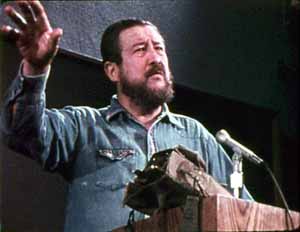
This is not a time of radical, revolutionary politics. Not yet. Unrest, riot, dissent and chaos notwithstanding, today’s politics is reactionary. Both left and right are reactionary and authoritarian. That is to say: Both are political. They seek only to revise current methods of acquiring and wielding political power. Radical and revolutionary movements seek not to revise but to revoke. The target of revocation should be obvious. The target is politics itself.
Radicals and revolutionaries have had their sights trained on politics for some time. As governments fail around the world, as more millions become aware that government never has and never can humanely and effectively manage men’s affairs, government’s own inadequacy will emerge, at last, as the basis for a truly radical and revolutionary movement. In the meantime, the radical-revolutionary position is a lonely one. It is feared and hated, by both right and left — although both right and left must borrow from it to survive. The radical-revolutionary position is libertarianism, and its socioeconomic form is Laissez-faire capitalism.
Libertarianism is the view that each man is the absolute owner of his life, to use and dispose of as he sees fit: that all man’s social actions should be voluntary: and that respect for every other man’s similar and equal ownership of life and, by extension, the property and fruits of that life, is the ethical basis of a humane and open society. In this view, the only — repeat, only — function of law or government is to provide the sort of self-defense against violence that an individual, if he were powerful enough, would provide for himself.
If it were not for the fact that libertarianism freely concedes the right of men voluntarily to form communities or governments on the same ethical basis, libertarianism could be called anarchy.
Laissez-faire capitalism, or anarchocapitalism, is simply the economic form of the libertarian ethic.
–Karl Hess, The Death of Politics
Playboy (March 1969)
Now there are all kinds of intriguing things going on here; and there are all kinds of insights being mixed in with all kinds of errors. (I’m here to document anarcho-capitalism, not to praise it.) But whatever the case may be, it seems to me obvious that in Hess’s hands, the last possible thing on his mind, in adopting anarcho-capitalist
(rather than other common labels at the time — libertarian,
individualist,
free markets,
etc.) was devising a label to appeal to conservatives or businessmen, or to avoid the whiff of frightening radicalism. If anything, Hess’s point in adopting the label seems exactly the reverse — to emphasize that his picture of economic and political freedom is something that ought to scare the hell out of conservatives:
. . . The great flaw in conservatism is a deep fissure down which talk of freedom falls, to be dashed to death on the rocks of authoritarianism. Conservatives worry that the state has too much power over people. But it was conservatives who gave the state that power. It was conservatives, very similar to today’s conservatives, who ceded to the state the power to produce not simply order in the community but a certain kind of order.
It was European conservatives who, apparently fearful of the openness of the Industrial Revolution (why, anyone could get rich!), struck the first blows at capitalism by encouraging and accepting laws that made the disruptions of innovation and competition less frequent and eased the way for the comforts and collusions of cartelization.
Big business in America today and for some years has been openly at war with competition and, thus, at war with laissez-faire capitalism. Big business supports a form of state capitalism in which government and big business act as partners. Criticism of this statist bent of big business comes more often from the left than from the right these days, and this is another factor making it difficult to tell the players apart. John Kenneth Galbraith, for instance, has most recently taken big business to task for its anticompetitive mentality. The right, meantime, blissfully defends big business as though it had not, in fact, become just the sort of bureaucratic, authoritarian force that rightists reflexively attack when it is governmental.
The left’s attack on corporate capitalism is, when examined, an attack on economic forms possible only in collusion between authoritarian government and bureaucratized, nonentrepreneurial business. It is unfortunate that many New Leftists are so uncritical as to accept this premise as indicating that all forms of capitalism are bad, so that full state ownership is the only alternative. This thinking has its mirror image on the right.
It was American conservatives, for instance, who very early in the game gave up the fight against state franchising and regulation and, instead, embraced state regulation for their own special advantage. Conservatives today continue to revere the state as an instrument of chastisement even as they reject it as an instrument of beneficence. . . . For many conservatives, the bad dream that haunts their lives and their political position (which many sum up as “law and order” these days) is one of riot. To my knowledge, there is no limit that conservatives would place upon the power of the state to suppress riots.
Even in a laissez-faire society, of course, the right to self-defense would have to be assumed, and a place for self-defense on a community basis could easily be imagined. But community self-defense would always be exclusively defensive. Conservatives betray an easy willingness to believe that the state should also initiate certain offensive actions, in order to preclude trouble later on. “Getting tough” is the phrase most often used. It does not mean just getting tough on rioters. It means getting tough on entire ranges of attitudes: clipping long hair, rousting people from parks for carrying concealed guitars, stopping and questioning anyone who doesn’t look like a member of the Jaycees, drafting all the ne’er-do-wells to straighten them up, ridding our theaters and bookstores of “filth” and, always and above all, putting “those” people in their place. To the conservative, all too often, the alternatives are social conformity or unthinkable chaos.
Even if these were the only alternatives — which they obviously aren’t — there are many reasons for preferring chaos to conformity. Personally, I believe I would have a better chance of surviving — and certainly my values would have a better chance of surviving — with a Watts, Chicago, Detroit, or Washington in flames than with an entire nation snug in a garrison. . . .
–Karl Hess, The Death of Politics
Playboy (March 1969)
In spite of the in-your-face radicalism of the essay, and the overt hostility to both conservatives and to big business, Hess is actually much more tentative about the anarcho
than he is about capitalism;
but he makes clear that the anti-politics that he envisions does, ultimately, mean the abolition of the state as such:
. . . Conservatives and liberals alike hold in common the mystical notion that nations really mean something, probably something permanent. Both ascribe to lines drawn on maps — or in the dirt or in the air — the magical creation of communities of men that require sovereignty and sanction. The conservative feels this with exaltation when he beholds the Stars and Stripes. The liberal feels this with academic certitude when he concludes that Soviet boundaries must be “guaranteed” to prevent Soviet nervousness. Today, in the ultimate confusion, there are people who feel that the lines drawn by the Soviet Union, in blood, are better than the lines drawn, also in blood, by American foreign policy. Politicians just think this way.
The radical and revolutionary view of the future of nationhood is, logically, that it has no future, only a past — often an exciting one, and usually a historically useful one at some stage. But lines drawn on paper, on the ground or in the stratosphere are clearly insufficient to the future of mankind.
Again, it is technology that makes it feasible to contemplate a day in which the politics of nationhood will be as dead as the politics of power-wielding partisanship. First, there is enough information and wealth available to ensure the feeding of all people, without the slaughtering of some to get at the possessions of others. Second, there is no longer any way to protect anything or anybody behind a national boundary anyway.
Not even the Soviet Union, with what conservatives continue to fear as an “absolute” control over its people, has been able to stop, by drawing lines or executing thousands, the infusion of subversive ideas, manners, music, poems, dances, products, desires. If the world’s pre-eminent police state (either us or them, depending on your political point of view) has been unable to protect itself fully behind its boundaries, what faith can or should we, the people, retain in boundaries?
It is to be expected that both liberals and conservatives respond to the notion of the end of nationhood with very similar shouts of outrage or jerks of reaction. The conservative says it shall not be. There will always be a U.S. Customs Inspector and long may he wave. The liberal says that far from ending nationhood, he wants to expand it, make it world-wide, to create a proliferation of mini- and micronations in the name of ethnic and cultural preservation, and then to erect a great super-bureaucracy to supervise all the petty bureaucracies.
Like Linus, neither liberal nor conservative can bear the thought of giving up the blanket — of giving up government and going it alone as residents of a planet, rather than of a country. Advocates of isolationism (although some, admittedly, defend it only as a tactic) seem to fall into a paradox here. Isolationism not only depends upon nationhood, it rigidifies it. There is a subcategory of isolationism, however, that might avoid this by specifying that it favors only military isolationism, or the use of force only for self- defense. Even this, however, requires political definitions of national self-defense in these days of missiles, bases, bombers, and subversion.
–Karl Hess, The Death of Politics
Playboy (March 1969)
And his particular interest in that essay — again, the closest thing that I have been able to find to a first coining and founding document for self-described anarcho-capitalism
— is to insist that consistent libertarians and radicals should support voluntary socialism, black revolution, and the New Left student radicals.
. . . I recall very vividly a comment on this subject by Roy Innis, the national director of the Congress of Racial Equality. He spoke of Mayor John Lindsay’s typically liberal zeal in giving money to black people, smothering them with it — or silencing them. Innis then said that the one thing Mayor Lindsay would not give the blacks was what they really wanted: political power. He meant that the black community in Harlem, for instance, rather than being gifted with tax money by the bushel, would prefer to be gifted with Harlem itself. It is a community. Why shouldn’t it govern itself, or at least live by itself, without having to be a barony of New York City Ward politics? However, I take exception to the notion of merely building in Harlem a political structure similar to but only separate from New York City’s. And I may be doing Mr. Innis, who is an exceptional man, an injustice by even suggesting that that is what he had in mind.
But beyond this one instance, there is implicit in the very exciting undercurrents of black power in this country an equally exciting possibility that it will develop into a rebellion against politics itself. It might insist upon a far less structured community, containing far more voluntary institutions within it. There is no question in my mind that, in the long run, this movement and similar ones will discover that laissez-faire is the way to create genuine communities of voluntarism. Laissez-faire is the only form of social/economic organization that could tolerate and even bless a kibbutz operating in the middle of Harlem, a hippie selling hashish down the street, and, a few blocks farther on, a firm of engineers out to do in Detroit with a low-cost nuclear vehicle.
The kibbutz would represent, in effect, a voluntary socialism — what other form could free men tolerate? The hash seller would represent institutionalized — but voluntary — daydreaming, and the engineers would represent unregulated creativity. All would represent laissez-faire capitalism in action and none would need a single bureaucrat to help, hinder, civilize or stimulate. And, in the process simply of variegated existence, the residents of this voluntary community, as long as others voluntarily entered into commerce with them, would solve the “urban” problem in the only way it ever can be solved; i.e., via the vanishment of politics that created the problem in the first place.
. . . Student dissenters today seem to feel that somehow they have crashed through to new truths and new politics in their demands that universities and communities be made responsive to their students or inhabitants. But most of them are only playing with old politics. When the dissenters recognize this, and when their assault becomes one against political power and authority rather than a fight to gain such power, then this movement may release the bright potential latent in the intelligence of so many of its participants. Incidentally, to the extent that student activists the world over are actually fighting the existence of political power, rather than trying to grab some of it for themselves, they should not be criticized for failing to offer alternative programs; i.e., for not spelling out just what sort of political system will follow their revolution. What ought to follow their revolution is just what they’ve implicitly proposed: no political system at all.
The style of SDS so far seems most promising in this respect. It is itself loosely knit and internally anti-authoritarian as well as externally revolutionary. Liberty also looks for students who rather than caterwauling the establishment will abandon it, establish their own schools, make them effective and wage a concerned and concerted revolt against the political regulations and power that, today, give a franchise to schools — public and private — that badly need competition from new schools with new ideas.
Looking back, this same sort of thinking was true during the period of the sit-ins in the South. Since the enemy also was state laws requiring separate facilities, why wasn’t it also a proper tactic to defy such laws by building a desegregated eating place and holding it against hell and high water? This is a cause to which any libertarian could respond.
Similarly with the school situation. Find someone who will rebel against public-education laws and you will have a worthy rebel indeed. Find someone who just rants in favor of getting more liberals, or more conservatives, onto the school board, and you will have found a politically oriented, passé man — a plastic rebel.
. . . Politics has always been the institutionalized and established way in which some men have exercised the power to live off the output of other men. But even in a world made docile to these demands, men do not need to live by devouring other men.
Politics does devour men. A laissez-faire world would liberate men. And it is in that sort of liberation that the most profound revolution of all may be just beginning to stir. It will not happen overnight, just as the lamps of rationalism were not quickly lighted and have not yet burned brightly. But it will happen — because it must happen. Man can survive in an inclement universe only through the use of his mind. His thumbs, his nails, his muscles and his mysticism will not be enough to keep him alive without it.
–Karl Hess, The Death of Politics
Playboy (March 1969)
Does this mean that the anarcho-capitalists are right, that anarchism is or even could be capitalist, or that Hess was right to adopt the labels he did? Absolutely not. Does it mean that market anarchists ought to be comfortable with capitalism
as an identity or that Hess’s understanding of it is particularly consistent? Like I said, I got some views of my own on that, and I think that there are several interrelated mistakes in a view like this one; some of which are related to what the term has come to mean in more recent debates.
But if we are going to try to read the anarcho-capitalists with understanding, then it is important to keep a clear eye on where this formulation and this tradition actually came from, at the time that it emerged. The term was coined in in-your-face, hyper-radical documents from the most Left-oriented figures within the lazy-fairy scene; it came from people who had the most interest in putting forward the revolutionary edge of the things that they believed in, and the greatest hostility towards both conservatives and conventional big business. And with that in mind it is important for left-libertarians to make our arguments against anarcho-capitalism on fair ground, to differentiate ourselves through serious, substantial argument not by means of under-sourced, and implicitly self-flattering, narratives about the motives and origins of our opponents.
(Of course, you may think that there is not much pay-off in spending much time with anarcho-capitalist writing, or in trying to read it with understanding. I’d hardly blame you if you came to that conclusion; everyone has limited time and there are many other things to read. But then if so, then probably you shouldn’t put too much effort into making broad statements about what anarcho-capitalism is, what motivates it, or where it comes from.)
Also.
- GT 2007-12-01: Benjamin Tucker on anarcho-capitalism
- GT 2011-04-02: Friday’s reading: one on post-WWII bohemian-anarchism, one on early anarcho-capitalism, and some mutualist portraits
- [1]In particular, the attempt to attach freed market ideals to something looking a lot like stereotypical commercialism and existing capitalist modes of ownership and production have tended to produce economic writing that completely ignores all the most important factors in economic life, strips freed markets of their most distinctively disruptive and anarchistic characteristics, and in fact strips them also of their most distinctively market-like operations.↩
- [2]For example the common delusion that libertarian ideas will somehow naturally appeal to social and economic conservatives; or the insane belief that statist controls come mostly from populist agitation and mostly victimize the wealthy or socially well-connected — when in fact they have largely been the result of concerted and deliberate big-business campaigns to increase the scope and power of the state and to regulate industries in their own benefit — campaigns whose effects have inevitably benefited well-entrenched industrialists and financiers.↩
- [3]For example, our understanding of the 19th century anti-capitalist individualist anarchists would be much thinner, and much poorer, if not for the work that has been put in by pro-capitalist writers like Carl Watner and Wendy McElroy, publishing in anarcho-capitalist forums like Journal of Libertarian Studies and Independent Review.↩
- [4]See for example
Anarcho-Rightism
, October 1969, andThe Movement Grows
, June 1969.↩ - [5]If I had to guess, my guess would be that it was introduced later, after the talk. Wollstein originally called his talk
Government Without Coercion,
and his comments about what he changed in making the booklet and why he changed it, seem to suggest that his revisions were largely in the direction of framing his view as more explicitly anarchistic, probably as a result of conversations with Roy Childs, who was already calling himself ananarchist
by this time.↩ - [6]And if you have a counter-example, hit me up with it in the comments — this is an ongoing research project.↩
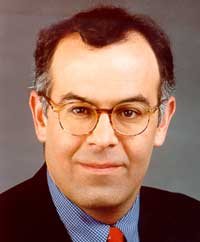
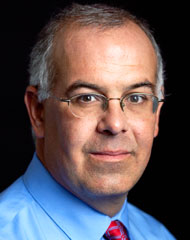
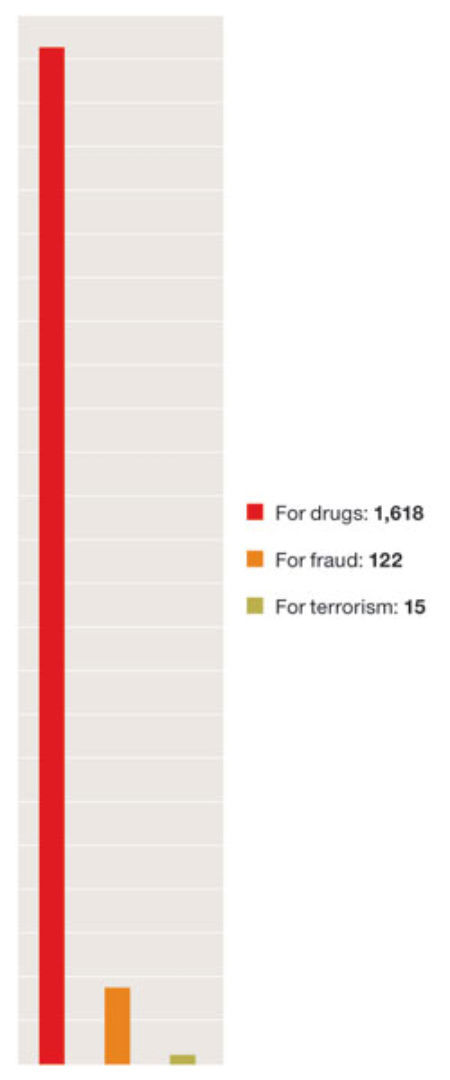

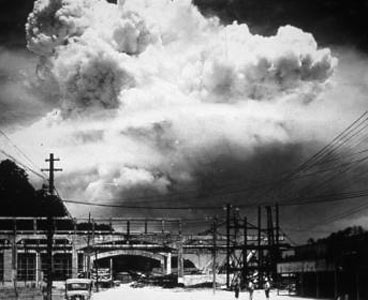
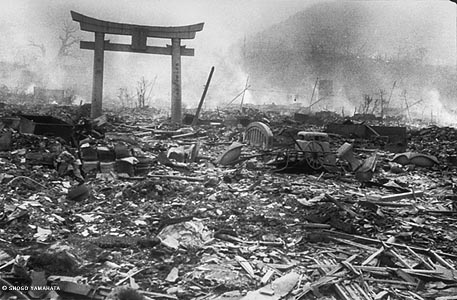
 It was over this section of Nagasaki that the second atomic bomb exploded at 11:02 a.m., August 9, 1945. The damages inflicted on Nagasaki by the atomic bombing defy description. The 20 machi or neighborhoods within a one kilometer radius of the atomic bombing were completely destroyed by the heat flash and blast wind generated by the explosion and then reduced to ashes by the subsequent fires. About 80% of houses in the more than 20 neighborhoods between one and two kilometers from the hypocenter collapsed and burned, and when the smoke cleared the entire area was strewn with corpses. This area within two kilometers of the hypocenter is referred to as the
It was over this section of Nagasaki that the second atomic bomb exploded at 11:02 a.m., August 9, 1945. The damages inflicted on Nagasaki by the atomic bombing defy description. The 20 machi or neighborhoods within a one kilometer radius of the atomic bombing were completely destroyed by the heat flash and blast wind generated by the explosion and then reduced to ashes by the subsequent fires. About 80% of houses in the more than 20 neighborhoods between one and two kilometers from the hypocenter collapsed and burned, and when the smoke cleared the entire area was strewn with corpses. This area within two kilometers of the hypocenter is referred to as the